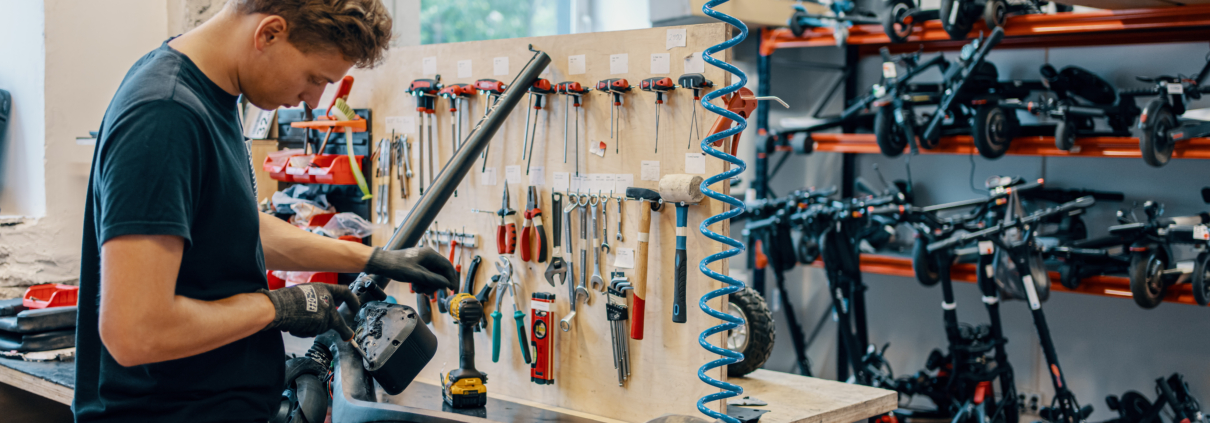Mistakes People Make When Riding Electric Scooters
Electric scooters are straightforward to ride since they are familiar. However, not many people know how to ride electric scooters correctly. This short electric scooter tutorial highlights the most common blunders people make when riding around in an electric scooter. Most points here are rookie mistakes, but seasoned riders should go through the list as a refresher. It also includes electric scooter riding instructions to assist you in correcting any flaws.
Improper tire pressure
Virtually all-electric scooter producers use solid or inflatable tires. Solid tires have certain benefits, but inflatable tires are typically the greatest alternative. Inflatable tires provide a considerably smoother ride than solid ones, but if you don’t keep them properly inflated, the quality of the ride will be severely affected.
Your e-scooter’s handling will suffer when your tires run too low. This is because the tire swings about on the wheel and deforms. Running your tire pressures excessively low has another consequence: they’re more likely to get punctures.
A “pinch flat” occurs when the inner tube is compressed against the wheel rim as it bounces over a pothole. It’s inconvenient to get stranded on your commute with a puncture. However, properly inflating your tires is not difficult.
It’s good to purchase a reliable pump with a pressure gauge from a bike shop. The correct pressure is often marked on the tire wall in PSI or Bar, so you know how much air to put in. You may further decrease the likelihood of potholes by utilizing tire sealant. Tyre sealant is a liquid you put inside your tires to fill holes as you ride.
Most of the time, you won’t know if a puncture has occurred with tire sealant. It will ensure that your tires will still be inflated and puncture-proof for your journey. Tire yogurt, for example, is an excellent illustration of tire sealant, which is used on all types of bicycles.
Caring about the electric scooter battery
Batteries for electric scooters are pretty complex. One of the most prevalent electric scooter blunders is failing to care for the battery correctly. If you care well for your battery, it will last a long time.
When riding an electric scooter, you might notice that your range is reduced even if the battery is fully charged. Batteries will generally indicate that they are complete before being entirely recharged in many circumstances. As a result, it’s preferable to trust what the charger says rather than relying on the battery indicator.
- Using the charger properly
By relying on the charger rather than the battery indicator, you will be sure that your battery is ultimately charged. It’s a good idea to avoid flat batteries altogether. If possible, keep your battery between 10% and 40% charged before recharging it.
After the battery is completely charged, remove it from the charger. Because you shouldn’t have to leave a fully charged battery unattended, the manufacturer will tell you how long it takes to charge.
If the battery takes considerably longer to charge than the manufacturer claims, your battery may issue. Alternatively, the battery is nearing the end of its life cycle.
- Knowing the limits
You’ll want to know how long your scooter’s battery will last when completely charged. You may arrange your journeys in this manner. As a result, you won’t be able to bring the battery down to 0%. The range of your scooter is determined by its model, battery size, and motor. However, the length of your journey will also be a factor since it’s uphill, how hard you accelerate, how big you ride, and whether or not your lights are on.
Proper Braking
A rear mudguard brake is available on sure electric scooters. You may use your foot to slow the rear wheel down by pressing it against it. On most electric scooters, the mudguard is simply a mudguard that prevents water and debris from ruining your pants. If you try to utilize your mudguard as a brake, you risk damaging your scooter or colliding.
Check out the manufacturer’s handbook to see if your rear mudguard is a brake or not. However, a sticker on the mudguard may bear the message “Do Not Step on It.”
Not learning about the e-scooter
It’s tempting to plug in your electric scooter and go for a spin once it arrives. You may believe that the machine is slower than the manufacturer claims, annoying. However, this might not be due to the scooter itself.
One of the most frequent electric scooter blunders is that new users don’t realize that their scooters are often set to “eco” mode, the lowest setting. This mode is sluggish, but it has the most incredible range. Electric scooters usually come with two additional speed settings for faster riding.
The quickest mode is more enjoyable and gets you there quicker. However, it uses up the battery at a much faster rate. With this in mind, you should resist the urge to ride and read the owner’s manual first. You will be completely informed on how to get the most from your electric scooter this way.
About the basics
If you’re new to riding an E-scooter, start slow and get used to controlling, stopping, and accelerating. Knowing how to ride an electric scooter is a piece of cake, but your first trip should be in a secure location. Avoid areas with many people and vehicles until you get the hang of it.
Many individuals are unaware that they must give their electric scooter a push start to begin. Your scooter won’t move unless you press the throttle. Your scooter must be slightly moving before the motor starts up. So, to get off to an wonderful start, push first, then press the throttle when you are ready.
Another crucial thing to know before you ride your new electric scooter is the local rules. Although not every country or city permits electric scooters on the roads and sidewalks, not all countries or cities ban them either. As a result, it’s critical to understand what’s permissible, so you don’t get into trouble. When riding an e-scooter, we recommend that you wear a helmet. You’re moving swiftly, so keeping your head safe is critical.










